Tronox Holdings Bundle
Who Really Controls Tronox Holdings Company?
Uncover the ownership secrets of Tronox Holdings Company, a titan in the titanium dioxide (TiO2) market, and discover how its ownership structure shapes its future. Understanding who owns Tronox is crucial for anyone looking to navigate the complexities of the global pigment industry and make informed investment decisions. The Tronox Holdings SWOT Analysis can provide further insights into the company's strengths and weaknesses.
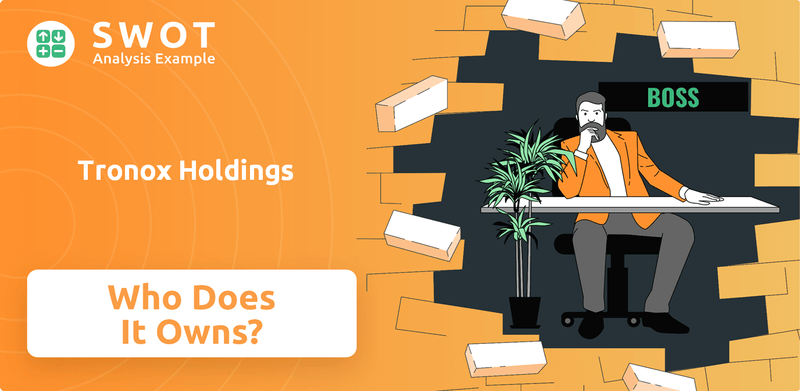
This exploration into Tronox ownership is essential for all stakeholders. From the individual investor considering Tronox stock to business strategists analyzing the competitive landscape, knowing who the Tronox shareholders are provides a critical advantage. We'll delve into the company's history, the influence of its Tronox investors, and the implications of its ownership for its operations and market position, including its annual revenue and business model.
Who Founded Tronox Holdings?
The story of Tronox Holdings Company begins not with founders, but as a spin-off from Kerr-McGee Corporation in 2005. This unique origin means the initial ownership structure differed significantly from that of a typical startup. Instead of individual entrepreneurs, the early ownership was distributed among Kerr-McGee's existing shareholders.
This corporate restructuring determined the initial stakeholders of Tronox. There were no angel investors or early-stage venture capitalists involved in the company's inception. The focus was on separating a specific business segment from a larger entity, setting the stage for Tronox to operate independently.
The early agreements centered on the transfer of assets, liabilities, and intellectual property from Kerr-McGee to the newly formed Tronox. The aim was to establish Tronox as a dedicated titanium dioxide producer. This strategic move allowed Tronox to concentrate on its core business operations.
The initial ownership of Tronox was dispersed among Kerr-McGee's existing shareholders. This distribution occurred as part of the spin-off process.
Unlike a startup, Tronox did not have individual founders in the traditional sense. It emerged from a corporate restructuring.
Early agreements focused on the transfer of assets and liabilities from Kerr-McGee. These agreements were crucial for establishing Tronox's operational independence.
The spin-off allowed Tronox to concentrate solely on its titanium dioxide business. This strategic separation was a key factor.
The initial investors were primarily the existing shareholders of Kerr-McGee. They became the first Tronox investors.
Tronox did not seek seed funding in its initial phase. The company's financial foundation was established through the spin-off.
The early days of Tronox ownership were defined by the transition from Kerr-McGee. The initial shareholders, who were also Kerr-McGee's shareholders, became the first Tronox shareholders. The focus was on establishing Tronox as an independent entity. The company's stock symbol is TROX. As of May 2024, the company's market capitalization is approximately $2.2 billion. The company's history is marked by significant events, including a period of restructuring and emergence from bankruptcy, which impacted the company's ownership structure. This history has shaped the company's strategic direction and its position within the titanium dioxide industry.
The initial ownership of Tronox was determined by the distribution of shares to Kerr-McGee shareholders, not by founders or angel investors.
- Tronox emerged as a spin-off, so there were no traditional founders.
- Early ownership was dispersed among Kerr-McGee's existing investors.
- Agreements focused on the transfer of assets and liabilities.
- The strategic separation allowed a focused approach on titanium dioxide production.
- Current market capitalization is around $2.2 billion (May 2024).
Tronox Holdings SWOT Analysis
- Complete SWOT Breakdown
- Fully Customizable
- Editable in Excel & Word
- Professional Formatting
- Investor-Ready Format
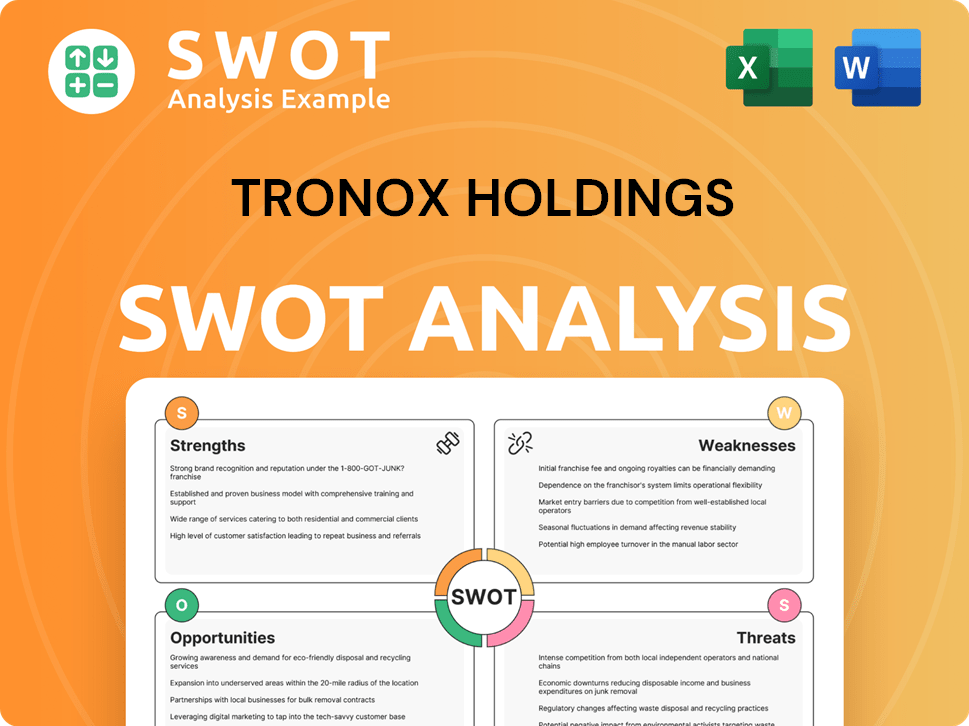
How Has Tronox Holdings’s Ownership Changed Over Time?
The ownership structure of Tronox Holdings Company has changed significantly since its spin-off in 2005. A key moment was its initial public offering (IPO), which broadened its shareholder base and marked its transition to a publicly traded company. As a publicly traded entity, shifts in Tronox ownership are primarily driven by institutional investors, mutual funds, and index funds, along with individual insiders. Understanding the evolution of Tronox ownership is crucial for investors and stakeholders alike.
The acquisition of Cristal's titanium dioxide business in 2019 also significantly impacted the ownership structure. This transaction, which involved issuing new shares, altered the company's capital structure and introduced new major investors. These strategic moves have reshaped the landscape of Tronox's shareholder base, reflecting its growth and evolution in the materials industry. Further insights into the company's financial performance and business model can be found in this article: Revenue Streams & Business Model of Tronox Holdings.
| Event | Impact on Ownership | Year |
|---|---|---|
| Spin-off | Established Tronox as an independent entity | 2005 |
| Initial Public Offering (IPO) | Broadened shareholder base, transitioned to public ownership | Post-2005 |
| Acquisition of Cristal's TiO2 business | Issued new shares, altered capital structure, introduced new investors | 2019 |
As of early 2025, institutional investors hold a substantial portion of Tronox's shares, often exceeding 80%. Major stakeholders include large asset management firms like Vanguard Group Inc. and BlackRock Inc. These firms frequently appear among the largest institutional holders. For example, in Q1 2025, institutional ownership might be around 85-90% of outstanding shares. These institutional investors influence company strategy and governance through their voting power. The company's stock symbol is TROX.
Tronox Holdings Company's ownership structure has evolved significantly since its IPO.
- Institutional investors are major shareholders.
- Acquisitions like Cristal's TiO2 business impacted ownership.
- Changes in holdings are reported in SEC filings.
- Understanding ownership is key for investors.
Tronox Holdings PESTLE Analysis
- Covers All 6 PESTLE Categories
- No Research Needed – Save Hours of Work
- Built by Experts, Trusted by Consultants
- Instant Download, Ready to Use
- 100% Editable, Fully Customizable
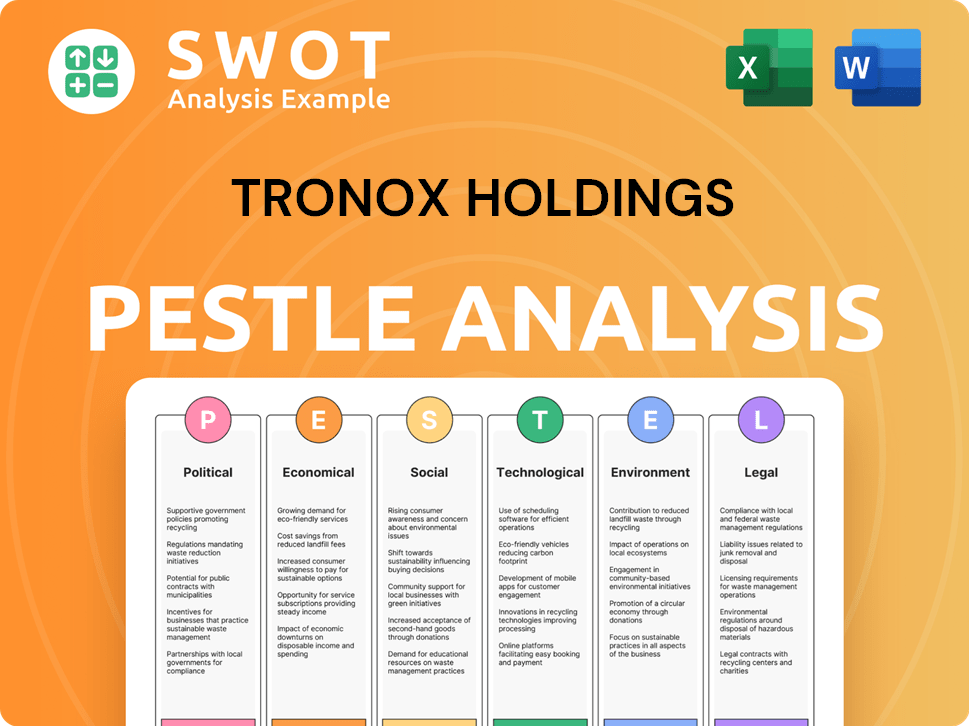
Who Sits on Tronox Holdings’s Board?
The Board of Directors of the Tronox Holdings Company plays a critical role in corporate governance, representing the interests of its shareholders. As of mid-2025, the board typically includes a mix of independent directors and executives. For example, John D. Romano serves as the independent Lead Director, and Jean-François Turgeon is the Chief Executive Officer. These individuals, along with other board members, bring diverse expertise in areas such as finance, operations, and international business. The composition ensures robust oversight and strategic guidance for the Tronox company.
The board's structure includes independent directors who do not represent specific major shareholders, aiming for unbiased judgment. The voting structure at Tronox Holdings Company is generally based on a one-share-one-vote principle, common for publicly traded companies. There are no known dual-class shares or special voting rights that would grant outsized control to any individual or entity. Board decisions significantly influence the company's strategic direction, capital allocation, and ultimately, shareholder value. The company's commitment to transparent governance is reflected in its financial reporting and investor relations practices, which are crucial for maintaining shareholder trust and ensuring long-term success. For further insights, consider reading about the Marketing Strategy of Tronox Holdings.
| Board Member | Title | Key Role |
|---|---|---|
| John D. Romano | Independent Lead Director | Provides unbiased oversight and guidance. |
| Jean-François Turgeon | Chief Executive Officer | Leads the company's strategic direction and operations. |
| Other Directors | Various | Bring diverse expertise in finance, operations, and international business. |
The voting structure at Tronox Holdings Company is based on a one-share-one-vote principle. This ensures that all Tronox shareholders have voting rights proportional to their share ownership. The board's decisions significantly influence the company's strategic direction and capital allocation, directly impacting Tronox stock value.
- The board includes independent directors for unbiased judgment.
- No dual-class shares or special voting rights exist.
- Major institutional shareholders influence decisions.
- Transparent governance is a key focus.
Tronox Holdings Business Model Canvas
- Complete 9-Block Business Model Canvas
- Effortlessly Communicate Your Business Strategy
- Investor-Ready BMC Format
- 100% Editable and Customizable
- Clear and Structured Layout
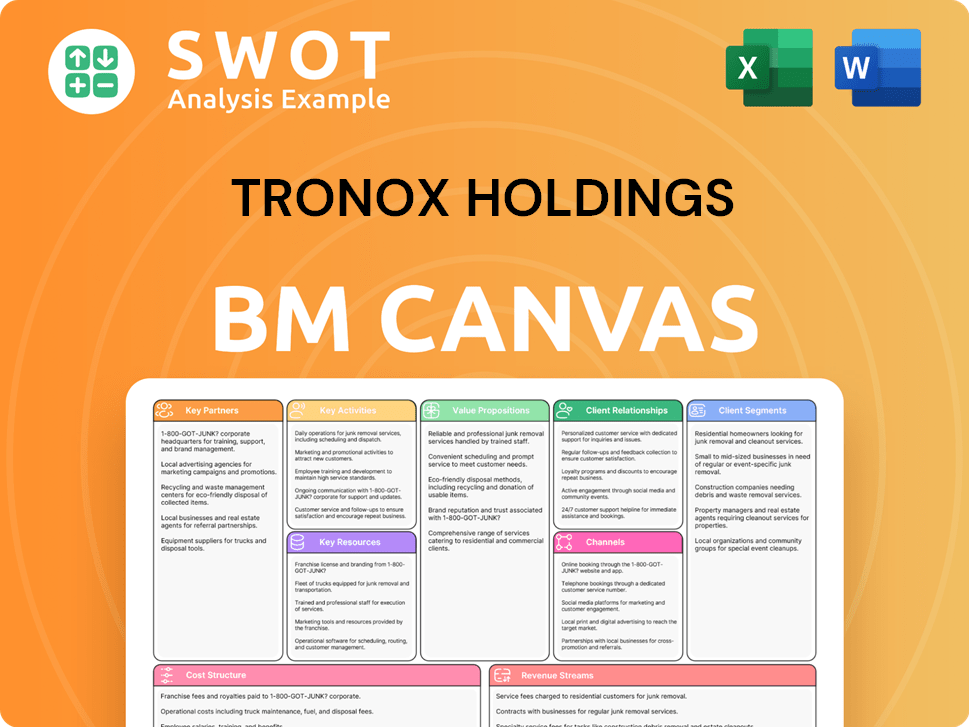
What Recent Changes Have Shaped Tronox Holdings’s Ownership Landscape?
Over the past few years (2022-2025), the ownership structure of Tronox Holdings Company has been influenced by broader industry trends. While there haven't been significant share buybacks or secondary offerings, the company's financial performance and market dynamics have played a key role in shaping investor sentiment and ownership patterns. The company's strategic financial management continues to influence investor behavior.
Industry trends often point towards increased institutional ownership in publicly traded companies like Tronox. Asset managers and index funds are major players, driven by passive investing strategies and portfolio diversification. The potential for consolidation within the chemical and mining sectors through mergers and acquisitions can also alter the ownership landscape. Recent activities have centered on operational optimization and integration, rather than major ownership changes.
| Ownership Trend | Impact | Details |
|---|---|---|
| Institutional Ownership | Increased | Driven by passive investment strategies and diversification. |
| Market Performance | Influences Investor Sentiment | Strong financial results can attract investors. |
| Strategic Focus | Operational Efficiency | Emphasis on integrating previous acquisitions. |
The focus for Tronox remains on delivering shareholder value through operational efficiency, sustainable practices, and strategic growth initiatives. The company is dedicated to the global TiO2 market. The stock symbol is TROX. For detailed insights, including the company's history, consider reading a Brief History of Tronox Holdings.
Major institutional investors typically hold significant stakes in Tronox. These can include large asset management firms and investment funds. The specific ownership percentages change over time due to market activities.
Yes, Tronox Holdings Company is a publicly traded company. Its stock is available for purchase on major stock exchanges. Investors can buy and sell shares based on market conditions.
To invest in Tronox stock, you need a brokerage account. Research the company, analyze its financial reports, and consider your investment goals. Consult with a financial advisor for personalized advice.
Tronox Holdings Company operates within the chemical industry, specifically focusing on the production and sale of titanium dioxide (TiO2) pigment. This pigment is used in various applications.
Tronox Holdings Porter's Five Forces Analysis
- Covers All 5 Competitive Forces in Detail
- Structured for Consultants, Students, and Founders
- 100% Editable in Microsoft Word & Excel
- Instant Digital Download – Use Immediately
- Compatible with Mac & PC – Fully Unlocked
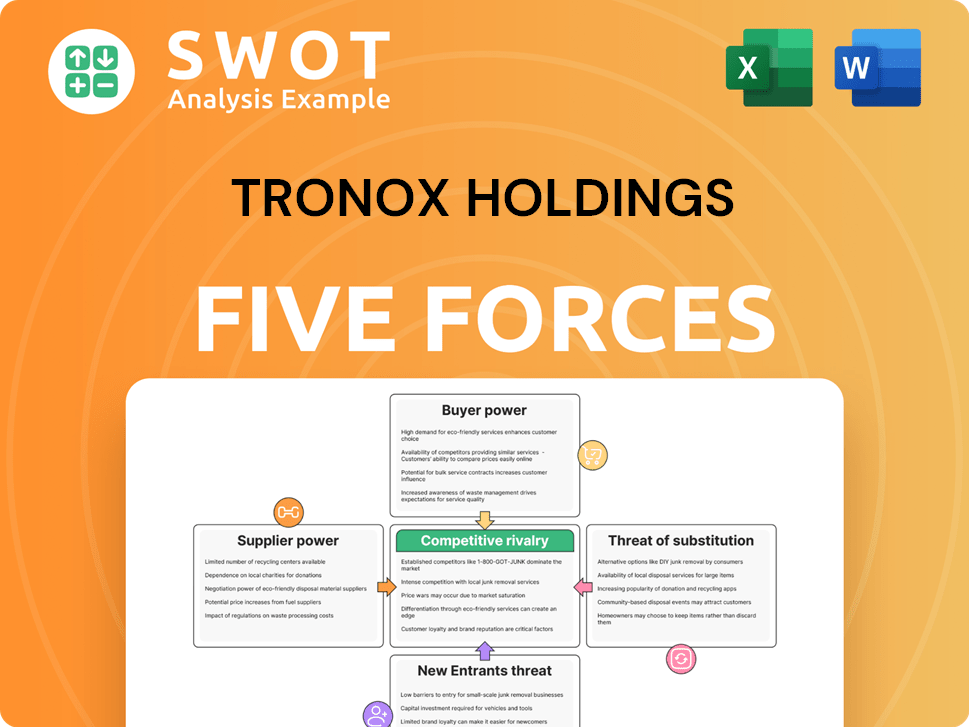
Related Blogs
- What are Mission Vision & Core Values of Tronox Holdings Company?
- What is Competitive Landscape of Tronox Holdings Company?
- What is Growth Strategy and Future Prospects of Tronox Holdings Company?
- How Does Tronox Holdings Company Work?
- What is Sales and Marketing Strategy of Tronox Holdings Company?
- What is Brief History of Tronox Holdings Company?
- What is Customer Demographics and Target Market of Tronox Holdings Company?
Disclaimer
All information, articles, and product details provided on this website are for general informational and educational purposes only. We do not claim any ownership over, nor do we intend to infringe upon, any trademarks, copyrights, logos, brand names, or other intellectual property mentioned or depicted on this site. Such intellectual property remains the property of its respective owners, and any references here are made solely for identification or informational purposes, without implying any affiliation, endorsement, or partnership.
We make no representations or warranties, express or implied, regarding the accuracy, completeness, or suitability of any content or products presented. Nothing on this website should be construed as legal, tax, investment, financial, medical, or other professional advice. In addition, no part of this site—including articles or product references—constitutes a solicitation, recommendation, endorsement, advertisement, or offer to buy or sell any securities, franchises, or other financial instruments, particularly in jurisdictions where such activity would be unlawful.
All content is of a general nature and may not address the specific circumstances of any individual or entity. It is not a substitute for professional advice or services. Any actions you take based on the information provided here are strictly at your own risk. You accept full responsibility for any decisions or outcomes arising from your use of this website and agree to release us from any liability in connection with your use of, or reliance upon, the content or products found herein.